Since ancient times the Japanese have taken in essential minerals, such as sodium, calcium, and potassium, as well as iodine by eating seaweed. Konbu, or edible kelp, is particularly important to Japanese cookery. Being rich in glutamine, a source of the savory taste known as umami, it is a basic ingredient of dashi stock alongside dried bonito.
A Cornerstone of Japanese Cooking
According to the article "Konbu ko" by Kunihiko Yasui, the word konbu shows up in Chinese documents as early as the third century. It is likely derived from kompu, an Ainu word referring to things that grow on underwater rocks. The word may have been introduced into the Chinese language through trade with Ainu-inhabited areas.
In earliest times konbu was eaten as a source of salt by stewing until it lost shape. The custom of making stock with konbu is thought to have originated around the tenth century. But now, after a millennium, this ancient tradition is beginning to erode from underneath.
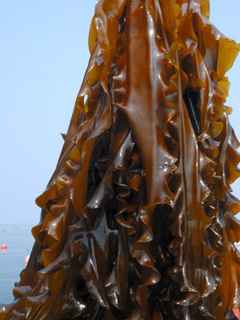
from the sea
Hokkaido, which produces 90 percent of the domestic kelp, boasted a total output of 26,000 tons a decade ago. The region continued to provide around 20,000 tons in subsequent years. In 2007, however, yields suddenly dropped to 13,000 tons.
Possible causes of the plunge include effects of the earthquake that occurred off the Sanriku coast the previous year, which hindered the spores from adhering to rocks, and the advancing age of fishers. But for producers, equally shocking was the indifference of consumers.
"The output halved, and yet it created no sensation. This makes me think that konbu for making dashi must not be selling anymore." So worries Shoichi Narita, who makes processed konbu products in the town of Ofunecho, Hakodate. The region's konbu yield in 2007 was less than 10 percent that of usual years.
"Japan is a volcanic country with largely acidic soil, and konbu is an important alkaline food that not only supplies us with minerals and sodium but neutralizes our bodies as well," explains Narita. "It also plays a role in purifying the ocean. Sometimes we hear about oil tankers sinking, but konbu purifies the oil-contaminated water in about seven years. And if you think of kelp beds as underwater forests, konbu greatly contributes to reducing carbon dioxide. Konbu and wakame here in the north are comparable to the mangroves of the south."
Paving the Way to Konbu Culturing
Since 2003 Narita has been an officer of the Donan Traditional Food Cooperative, which works with fishers belonging to the Osatsube branch of JF (Japan Fisheries Cooperative) Minamikayabe. Osatsube is a beach town known for its high-quality makonbu, a variety that the local Matsumae clan used to present to the imperial court and the Edo shogunate. Scientifically known as Laminaria japonica Areschoug, makonbu grows to between 30 and 40 centimeters in width and anywhere from 2 to 10 meters in length.
The trouble with wild konbu is that it needs to grow for at least two years before it can be harvested, and years of high and low yields make for an unstable business. Moreover, its beds are slowly being depleted.
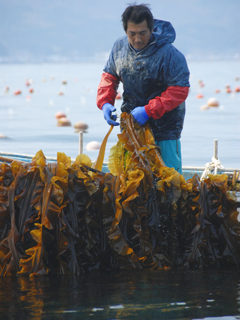
Hoping to find a solution, Iwao Okawa and other fishers of Osatsube set out to cultivate konbu that can be harvested in a year. At around the same time, young fishers in neighboring Kakkumi began developing konbu farming under the cooperation of Yoshio Hasegawa, then of the Hokkaido National Fisheries Research Institute. Hasegawa had succeeded in growing konbu spores in tanks until they were large enough for use as starters.
In Osatsube, the idea of konbu farming met with strong opposition by people who feared its effect on wild konbu. "It took three years just to set up a rope," recalls Okawa. Furthermore, the fishers were unable to obtain grown sporelings from an experiment station. Instead, they had to begin by collecting and raising spores drifting in the ocean.
Okawa showed us a journal filled with detailed records of their efforts at the time, which were "a series of one challenge after another." The number of advocates was initially about 30, but now roughly 140 out of the 330 konbu fishers of Osatsube Beach rely on konbu cultivation. People agree that kelp fishing at the beach would not have survived if it were not for konbu farming.
Five years ago the fisheries cooperatives of Osatsube, Kakkumi, Ofune, Usujiri, Yasuura, and Kinaoshi were merged into JF Minamikayabe. With 1,200 members, it is now Hokkaido's second largest fisheries cooperative. That the Minamikayabe district alone produces nearly 20 percent of the domestic konbu owes in large part to cultivated kelp.
Growth of Konbu
The town of Kakkumi in Minamikayabe was a national pioneer in konbu farming. Because cultivated konbu can be harvested in a year, half the time needed for wild konbu, it is also known as sokusei (forced) konbu. It was in 1966 that a test and research project on sokusei konbu under the Hokkaido Regional Development Bureau was launched here. About five young members of the local fisheries cooperative, including Suteyoshi Yoshimura, signed up for the project led by Yoshio Hasegawa.
After nearly a decade, 6 tons were harvested in 1975. Today the Minamikayabe district, which includes both Kakkumi and Osatsube, produces 3,300 tons of cultivated konbu . Konbu farming has come to firmly bolster the local economy.
The production cycle differs between cultivated and wild konbu . The former is grown in the following manner.
1. Spores are obtained from the local seedling center before December and cultured for 50 days before being released in the ocean. (Some people, including Okawa, collect spores directly from the ocean in late August and culture them.) The sporelings should adhere to ropes in three to four days.
2. The sporelings are thinned out in mid-December.
3. In mid-January they are transplanted to culture ropes, to which the holdfasts (the root-like bases) are secured.
4. In April the water level is adjusted for the first of several times. Plastic bottles or buoys are used to regulate the depth of the ropes, which are lowered as the kelp fronds lengthen so as to allow for further growth while maximizing sun exposure. The depth is adjusted again in May and in June. Young konbu fronds are deep green.
5. The konbu is harvested from around late July, when the fronds have thickened and turned reddish brown.
Konbu is cultivated in China as well using techniques developed by the Japanese, partly for the added benefit of its purification ability. Today China produces 4 times as much konbu as it did in the 1960s and around 20 times more than Japan does.
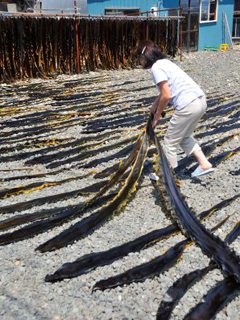
beach to dry.
Wild konbu is subject to tight harvest restrictions to prevent overexploitation. The restrictions differ from region to region, and fishers belonging to JF Minamikayabe can only harvest konbu for an average of 4 or 5 days a week, to a maximum of 25 days, between the end of July and October. Harvest is called off on stormy days, the sign of which is a red flag raised on the beach early in the morning. This is known as okiage and can last for days on end in some years. So when they do get a go-ahead, fishers harvest konbu in a wild frenzy during the half-day that they have. Local fishers use long poles called hoko to twist off the holdfast and haul the konbu on board. The boats return to shore loaded to near sinking, and women spread the konbu on the beach to dry in the sun.
The cycle of wild konbu is as follows.
1. Spores are released from the fronds and begin to drift in August.
2. They adhere to rocky surfaces from around November.
3. The spores grow into meter-long young plants, now visible from a short distance.
4. Around June the fronds begin to thicken, then wither down to about 30 centimeters.
5. Growth resumes in mid-October.
6. The fronds grow large enough to be harvested around July of the third year.
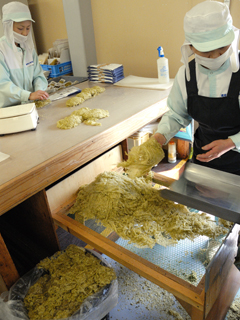
tororo kobu .
Wild konbu thus takes two years to fully grow. Makonbu has a lifespan of three years.
The Donan Traditional Food Cooperative, together with fishers of Osatsube, processes konbu into various products. The most popular product is tororo kobu, or shaved kelp flakes. Unlike commonly sold tororo kobu, theirs uses no sweeteners or preservatives.
To make tororo kobu, konbu is immersed in vinegar for a day and set aside for a week until it becomes thoroughly tender. It is then dried for a week. The dried fronds are trimmed to the same width, sprayed with vinegar, set aside for another week, and shaved. Machines have been used since the early twentieth century, but about 100 blades are dulled with every 100 kilograms of konbu shaved, and sharpening the blades is a chore. Konbu wholesalers go to even greater lengths to produce tororo kobu with a profound flavor. They spend as much as three years maturing the konbu, vinegaring it, and sun-drying it in the summer.
A Blessing of the Sea
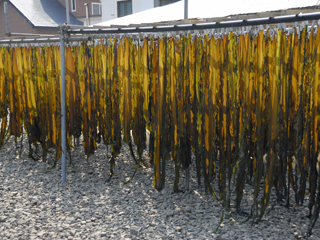
The Ofune Ruins in Minamikayabe are the remains of a colony dating to the Jomon period (around 14,000 BC to 400 BC). It is still in the course of being excavated, but 92 pit dwellings have been found to date, as well as a clay figure painted with red lacquer that has been designated a national treasure. These findings are proof of the cultural sophistication of the people who lived here.
Studies of the remains have revealed that the Japanese had already been eating konbu in the Jomon period. As kelp forests attract fish, the people of this area must have led a life blessed with the bounties of the seas.
A rich variety of fish are available even today in Minamikayabe, as the Tsugaru Warm Current and Oyashio Current meet near its shore. The region is also situated at the ideal latitude for konbu growth. The water temperature in the summer, when the spores drift, comes to the ideal range of 17 to 18 degrees Celsius, though the effects of global warming pose a possible threat to these conditions.
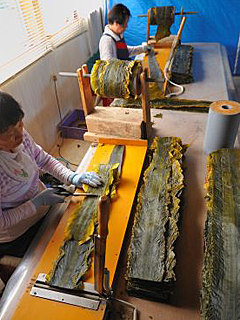
Yukimitsu Sato took us out on his boat in early summer to see the glossy young cultivated konbu, already several times human height. "Cultivating" konbu actually involves no feeding or fertilizing. The konbu simply grows on its own, embodying the wondrous power of the ocean and sun to nurture life. Once, when Narita inserted a toothpick to check its growth, he found that the konbu grew as much as 10 centimeters in a single day.
Konbu is a blessing, both as a habitat for fish and as food, and will keep supplying us with food as long as humans do not excessively harvest it. "I think it's amazing that the Japanese thought of eating this," Narita says.
But there is cause for concern in Minamikayabe, as in other konbu -producing areas. The average age of fishers is now over 60, and oil prices are rising. The least that consumers can do are to revert to using konbu for making dashi and learn about the people who support the production of a vital source of umami, the "fifth taste" that the world is coming to recognize.
Photos: Kazuo Kikuchi
